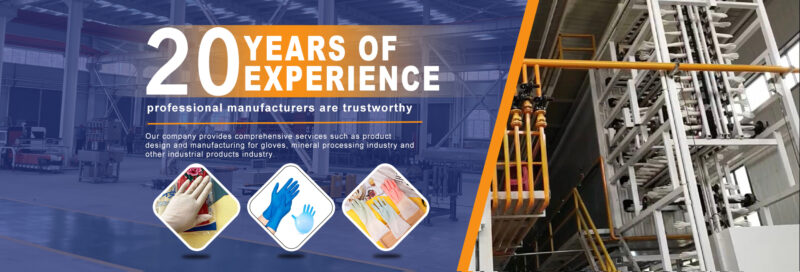Fengwang is one of the world’s leading manufacturers, suppliers, and exporters of disposable gloves production lines. With 20 years of R&D and manufacturing experience, we closely collaborate with our customers to develop unique and innovative solutions to address future challenges.

Fengwang’s Business Scope
- Modifications to the glove production line
- Improvement of production processes
- Design of factory construction drawings
- Proposals for production innovation
- Maintenance and repair of production machines
- Proposals for cost reduction and efficiency improvement
- Timely and effective after-sales service
Fengwang’s Strengths
- Over 70 employees
- Advanced Technology Engineering R&D Department
- Certified with the three systems of ISO 14001:2015, ISO 45001:2018, and ISO 9001:2015, and holds a CE certificate
- Owns 40+ patented products in machines such as packaging machines and point-of-sale machines
- Established a 24-hour customer solution center to provide technical support to global customers
- Strong technological research and development strength
- Latest drawing design software
Quick Facts About Fengwang
Fengwang is a one-stop service provider, offering a comprehensive supply of all machinery and components for glove production lines. The production line refers to the route that the product goes through during the production process, starting from the time the raw materials enter the production site and ending with a series of production line activities such as impregnation, drying, edge rolling, and demolding.
Fengwang, as a leader in glove production line solutions, with its long-standing control over the glove production market, ensures the healthy operation of machines in harsh environments through our solutions. Our innovative solutions sustainably accelerate efficiency for customers. The company is composed of seven departments: the Foreign Trade Department, the Production Department, the Finance Department, the Safety Department, the Engineering Technology Department, the Logistics Department, and the Quality Inspection Department. The company officially went public in January 2024, injecting new impetus and vitality into its development.
Enterprise Cost Reduction and Efficiency Enhancement Plan
Cost management optimization
Method 1: Propose a unified cost accounting system based on the current situation of the enterprise, establish a product accounting model, and form a closed-loop cost analysis and management mechanism; sort out and establish unified management norms for the collection, allocation, and transfer of production costs, thereby enabling cost accounting based on product categories and models; based on product ingredients, establish cost driving factor statistics, standardize the cost accounting logic and calculation formulas, and establish a base product cost accounting model.
Method 2: Establish a management mechanism that supports continuous improvement of product costs, including cost planning, cost accounting, factor analysis, and improvement implementation; through cost variance analysis, identify the key factors and responsible departments that affect cost changes; establish a weekly monitoring mechanism for the key items causing cost variances to drive the production workshop to improve and reduce costs; through management reports and business management meetings, monitor the achievement of the budget every month, and promote continuous improvement of the business.
Production management optimization
The two main factors that affect the company’s production efficiency are the improvement of equipment capacity and the enhancement of management efficiency. The improvement efforts will focus on seven key aspects: organizational division of labor, team management, equipment management, upgrading of process documents, promotion of 5S, visual management, and promotion of benchmarking units.
Thus, the goal of optimizing production management is achieved. A comprehensive set of production management mechanisms and process documents has been established, significantly increasing the unit’s capacity utilization rate and successfully fulfilling the sub-goal of reducing labor costs.

Quality Management Optimization
From the perspective of process quality management improvement methods, the focus is on improving product quality, stability, and key issues in the production process throughout the entire quality process control flow. Enterprises should carry out the work from six aspects: clarifying the definition of product defects, increasing the frequency of random inspections, establishing standards for appearance defects, conducting special project improvements, and implementing SPC control. Ultimately, the goal of quality management optimization is achieved, resulting in reduced production process costs and the realization of the objectives.



